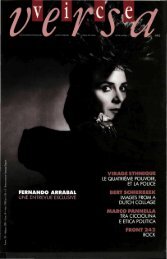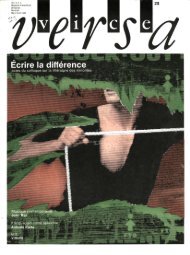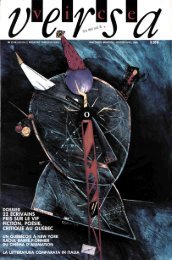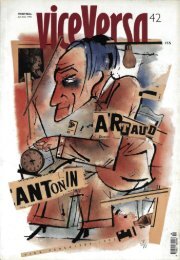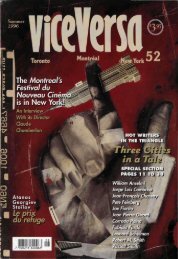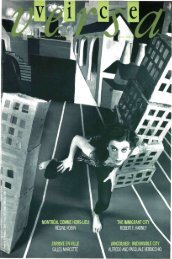N. 46/47 Palomar : voyeur, voyant, visionnaire - ViceVersaMag
N. 46/47 Palomar : voyeur, voyant, visionnaire - ViceVersaMag
N. 46/47 Palomar : voyeur, voyant, visionnaire - ViceVersaMag
Create successful ePaper yourself
Turn your PDF publications into a flip-book with our unique Google optimized e-Paper software.
tually changed the direction of their orthography<br />
from the left to the right, but only after<br />
they added vowels to their original model).<br />
The choice of direction depends on<br />
whether the reading process is based on combining<br />
letters by context (leftward) or stringing<br />
them in sequence (rightward).The brain<br />
recognizes configurations faster in the left<br />
visual field, while it detects sequences faster<br />
in the right visual field (the change of direction<br />
in the Greek script happened soon after<br />
a full complement of vowels was added to the<br />
exclusively consonantal orthography of<br />
Phoenician; vowels turned the quasi stenographicsystem<br />
of Phoenician into the fullyexplicit<br />
sequence of Greek letters).<br />
There is a feed-back effect on the kind<br />
of processing by the brain to read and write a<br />
given orthography which models the script<br />
accordingly (the emphasis<br />
on sequential processing in<br />
early Greek and Roman<br />
writing was reflected by<br />
their writing styles which<br />
were rigourously continuous<br />
without blanks or interruptions<br />
for words, sentences<br />
or even paragraphs;<br />
this was called by the<br />
Romans scriplio continua),<br />
The fact that our alphabet changed<br />
direction as soon as it achieved its full elaboration<br />
with the addition of vowels supports<br />
my hypothesis that it puts pressure on our<br />
brain to emphasize its sequencing and "timeordered"<br />
processing abilities. Since literacy is<br />
generally acquired at an early formative age<br />
and since it affects the organization of language,<br />
our most integral information-processing<br />
system, there are good reasons to suspect<br />
that the alphabet also affects the organization<br />
of our thought. Language is the software<br />
that drives the human organism.<br />
Anything that affects language in a significant<br />
way is likely to also affect behavior at the<br />
physical, emotional and mental levels. The<br />
alphabet is a program which combines<br />
power, precision, versatility and comprehensiveness,<br />
qualities required to run the most<br />
powerful instrument in existence: man himself.<br />
Indeed, there is no need to rely on<br />
genetic explanation for the differences of<br />
mentalities between East and West. The<br />
alphabet is the difference. The alphabet created<br />
two revolutions, one in the brain, and the<br />
other, in the world.<br />
THE REVOLUTION IN THE BRAIN.<br />
It is quite possible that we write to the right<br />
not only because that is how we have been<br />
taught to do it, but principally because that is<br />
how our brain and our muscular system want<br />
us to do it. Figure 1 shows how the visual system<br />
works in the brain. What most people do<br />
not know is that we do not only have two<br />
eyes, but four half-eyes, two halves for the left<br />
and two halves for the right. As you can see,<br />
the left halves are governed by the right side<br />
of the brain, while the right halves are ruled<br />
by the left side.<br />
This is of the utmost relevance to the<br />
question of the direction of orthographies.<br />
Clinical research shows that we do not see<br />
the same way to the left and to the right.<br />
What we see to the left is literally "comprehended",<br />
that is, taken all at once. But what<br />
we see to the right is analyzed bit-by-bit. In<br />
effect, the work of our eyes is divided like the<br />
work of our hands. The two left halves seize<br />
the world, and the two right halves cut it for<br />
us into its component parts. How relevant is<br />
this to the question of the alphabet? To read<br />
any writing system, you have to do two<br />
things:<br />
recognize the shape of the symbols<br />
analyze the sequence of symbols.<br />
Depending upon which is most urgent,<br />
FIGURE i. THE OPTIC CHIASM<br />
the shape or the sequence, the writing system<br />
will go left or right. If you have to guess and<br />
cross-check the writing, it is important to see<br />
the shape first. Because they have to guess the<br />
value of their unwritten vowels, Arabic and<br />
Hebraic readers have to cross-check their<br />
texts. To survey the whole field at once, our<br />
visual system works faster and better in the<br />
left field of vision. On the contrary, when we<br />
P a 1 o m a r<br />
read German or English, we need first and<br />
foremost to see the order of the letters one<br />
after the other. This is done faster and better<br />
in the right visual field. That is why our<br />
alphabet which is a linear, sequential system<br />
of coding information is written to the right.<br />
That is my primary hypothesis.<br />
My secondary hypothesis is that there<br />
must be a formidable feed-back loop effect of<br />
the alphabet on the brain.The alphabet trains<br />
the brain, not only to read, but also to think<br />
in terms of bits and pieces in proper<br />
sequence. Indeed, the big issue here is thinking.<br />
The real nature of thinking is speaking<br />
inside the mind without being interrupted by<br />
reality. To be able to think one must separate<br />
words from life, deal with the meanings of<br />
experience without having to go through the<br />
experience itself. It is also the alphabet which<br />
L - hemisphere - R *<br />
has taught us to separate thinking from direct<br />
experience. Even as we learn to cut speech<br />
into its basic elements, and. to put them back<br />
together again when we read, we are training<br />
our brain to do exactly that with life itself.We<br />
think in words and concepts arranged in logical<br />
sequences grammatically structured to<br />
represent and organize reality itself. We have<br />
invented and refined linear history, geogra-<br />
NUMÉRO 41-17 • VICEVERNA 33



